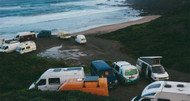CAN YOU GO OFF-GRID ON A SMALL BUGDET?
17th Dec 2021
The off-grid lifestyle has become a very popular choice for many people interested in reducing their carbon footprint and avoiding the reliance of fossil fuels. When transitioning to solar, some believe a higher output is more satisfying than a system with a smaller wattage. It’s true that a higher-output solar panel provides more electricity, allowing you to power or charge up more devices.
However, average costs for a 1000W solar panel system can be frighteningly expensive. Therefore, it’s wise to invest in a smaller solar panel configuration such as a 100-watt system which will adequately meet your power needs.
We recommend following the five steps below when using solar panels with a lower output.

l Don’t waste your electricity
Once your battery is full, any excess power produced by the panels goes to waste. Before going outside or beginning your travels, check the charge state of your battery. If your battery is full or nearly full, then feel free to use it to charge your phone, laptop, portable speakers, camera batteries, etc. Throughout the day, you can also power appliances with higher wattages, such as an electric pot or mini fridge.
l Always pay attention to the angel of your solar panel with relation to the sun
To allow for optimal performance, your solar panels should be pointed directly towards the rising sun. Taking advantage of the morning sunlight can harvest a lot more energy than you would expect. Furthermore, you should be aware of the sun's trajectory as it travels in the sky throughout the day and be sure to place your solar panels in the best overall position that absorbs the highest amount of light for charging. You’ll be thrilled to see how making just a few simple adjustments can have a huge impact on your power meters.

l Use 12-volt appliances if possible
Simply put, you will save the most amount of energy if you use DC power directly from your batteries, instead of turning it into AC power through an inverter. Consider pairing a 12V light with a 12V ventilation fan and prepare a portable power station to charge small electronics.
l Keep your battery charging while driving
There are three ways to accomplish this. The first option would be to apply a DC-to-DC charge controller that uses the 12V power generated by your cars alternator to charge your battery. Secondly, you can fix brackets onto the roof of your camper and mount your solar panels on them, allowing the sunlight to shine directly on the panels while driving. The third option is more strategic and encourages you to park in direct sunlight to get your battery charged.

l Cut down your energy consumption
Electricity powers many of the cooking devices that we traditionally use in our homes, but it's not the only energy source to make great food. A portable camping stove is a great option that allows you to cook over a campfire instead. You can sauté and bake in a pan or put a kettle on the stove and enjoy your daily tea or coffee. Since fuel is cheaper, imagine having to spend a total of about $100 a year, which will provide you with enough propane for all your heating and cooking needs year-round.

You can power LED lighting as well as wall fixtures, the ventilation fan, charge your laptop, smartphones, other personal electronics, and a few small household appliances such as a blender or microwave. Keep your needs simple to minimize your overall power usage and costs.
